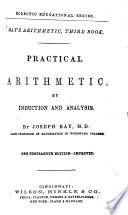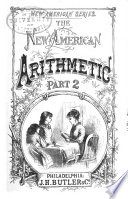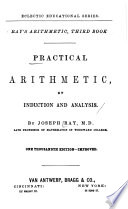 ... that is, the fraction takes its name or denomination from the number of parts, into which the unit is divided. Thus, if the unit be divided into 16 parts, the parts are called sixteenths, and 5 of these parts would be 5 sixteenths, expressed thus,... ... that is, the fraction takes its name or denomination from the number of parts, into which the unit is divided. Thus, if the unit be divided into 16 parts, the parts are called sixteenths, and 5 of these parts would be 5 sixteenths, expressed thus,...  Treatise on Arithmetic, Practical and Theoretical - Page 149by Dionysius Lardner - 1834 - 353 pagesFull view Treatise on Arithmetic, Practical and Theoretical - Page 149by Dionysius Lardner - 1834 - 353 pagesFull view - About this book
 | Nathan Daboll - Arithmetic - 1843 - 254 pages
...equal parts, they are ninths, and so on : that is, the fraction takes its name or denomination from the number of parts into which the unit is divided. Thus, if the unit be divided into 15 equal parts, they are fifteenths ; if into 20 equal parts, they are twentieths,... | |
 | Nathan Daboll, David Austin Daboll - Arithmetic - 1849 - 260 pages
...equal parts, they are ninths, and sa on : that is, the fraction takes its name or denomination from the number of parts into which the unit is divided. Thus, if the unit be divided into 15 equal parts, they are fifteenths ; if into 20 equal parts, they are twentieths,... | |
 | Joseph Ray - Arithmetic - 1857 - 358 pages
...into equal parts, -vrtxfct ate Viic, ywV* nalkd ? ART. 123. The value of one of the parts depends on the number of parts into which the unit is divided. Thus, if 3 apples of equal size be divided, one into 2, another into 3, and another into 4 equal parts, the... | |
 | Joseph Ray - Arithmetic - 1866 - 212 pages
...many twenty-fourths? VALUE OF FEACTIONS. 9O. The Value of one of the parts of a fraction depends upon the number of parts into which the unit is divided. Thus, if an apple is divided into two equal parts, or halves, the parts are larger than if divided into three... | |
 | Samuel Mecutchen - 1877 - 128 pages
...by dividing the numerator by the denominator. Thus, J¥2 = 1 2 -e- 2 = 6. Fractions are named from the number of parts into which the unit is divided. Thus, if we divide anything into 2 equal parts, the parts are called halves ; if into 3 equal parts, thirds, etc.... | |
 | Joseph Ray - Arithmetic - 1879 - 200 pages
...twenty sixteenths ? VALUE or FRACTIONS. 92. The Value of one of the parts of a fraction depends upon the number of parts into which the unit is divided. Thus, if an apple is divided into two equal parts, or halves, the parts are larger than if divided into three... | |
 | Joseph Ray - Arithmetic - 1885 - 358 pages
...divide by a composite number ? What is Rule H ? • . ART. 123. The value of one of the parts depends on the number of parts into which the unit is divided. Thus, if 3 apples of equal size be divided, one into 2, another into 3, and another into 4 equal parts, the... | |
 | Joseph Ray - Arithmetic - 1866 - 210 pages
...many twenty-fourths? VALUE OF FEACTIONS. OO. The Value of one of the parts of a fraction depends upon the number of parts into which the unit is divided. Thus, if an apple is divided into tico equal parts, or halves, the parts are larger than if divided into three... | |
| |